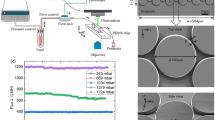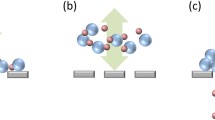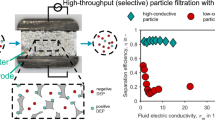Abstract
Investigations of membrane fouling at the pore-scale have long been of limited interest due to microstructural defects of the commercial membranes that prevent any quantitative analysis of the experimental results. In this paper, we employed novel microengineered membranes with regular pore size to investigate the effect of the membrane pore geometry on the fouling mechanisms during filtration of micron-sized particles. For particles larger than the membrane pore size, the fouling mechanism was pore blockage followed by the cake filtration, while pore narrowing was the dominant mechanism when particles were smaller than the membrane pore size. Filtration with the slotted pore membrane offers some interesting advantages comparing to the filtration with circular pores. The rate of flux decline was slower for the membrane with slotted pores compared with the membrane with circular pores since the initial particle deposition only covered a small fraction of the pores. It was also found that the flow resistance of the slotted pore membrane is much lower than the circular one because a slotted pore has a smaller perimeter than several circular pores with the same total surface area. We can conclude that by proper selection of membrane pore geometry, flux decline can be hindered while maintaining a high selectivity during microfiltration. These findings can be useful also for researchers who are using microfluidic platforms with integrated isopore filters for various applications such as stem cell enrichment, cancer cell isolation, blood fractionation and pathogen removal.






Similar content being viewed by others
References
Bacchin P, Aimar P, Sanchez V (1995) Model for colloidal fouling of membranes. AIChE J 41(2):368–376
Bacchin P, Marty A, Duru P, Meireles M, Aimar P (2011) Colloidal surface interactions and membrane fouling: investigations at pore scale. Adv Colloid Interface Sci 164(1):2–11
Baker RW (2004) Membrane technology and applications, 2nd edn. Wiely, New York
Brans G, van Dinther A, Odum B, Schroën C, Boom R (2007) Transmission and fractionation of micro-sized particle suspensions. J Membr Sci 290(1–2):230–240
Bromley A, Holdich R, Cumming I (2002) Particulate fouling of surface microfilters with slotted and circular pore geometry. J Membr Sci 196(1):27–37
Chandler M, Zydney A (2006) Effects of membrane pore geometry on fouling behavior during yeast cell microfiltration. J Membr Sci 285(1–2):334–342
Chen L, Warkiani ME, Liu H-B, Gong H-Q (2010) Polymeric micro-filter manufactured by a dissolving mold technique. J Micromech Microeng 20(7):075005
Coumans FA, van Dalum G, Beck M, Terstappen LW (2013) Filter characteristics influencing circulating tumor cell enrichment from whole blood. PLoS ONE 8(4):e61770
Dubitsky A, DeCollibus D, Ortolano GA (2002) Sensitive fluorescent detection of protein on nylon membranes. J Biochem Biophys Methods 51(1):47–56
Duclos-Orsello C, Li W, Ho CC (2006) A three mechanism model to describe fouling of microfiltration membranes. J Membr Sci 280(1–2):856–866
Fane A, Fell C (1987) A review of fouling and fouling control in ultrafiltration. Desalination 62:117–136
Giacomini KM, Huang SM, Tweedie DJ, Benet LZ, Brouwer KLR, Chu X, Dahlin A, Evers R, Fischer V, Hillgren KM (2010) Membrane transporters in drug development. Nat Rev Drug Discovery 9(3):215–236
Gironès M (2005) Inorganic and polymeric microsieves, strategies to reduce fouling. PhD Dissertation, University of Twente, Enschede, The Netherlands, vol 199, issue number 1–2, pp 41–52
Hermans P, Bredée H (1936) Principles of the mathematical treatment of constant-pressure filtration. J Soc Chem Ind 55:1T–4T
Ho CC, Zydney AL (1999) Effect of membrane morphology on the initial rate of protein fouling during microfiltration. J Membr Sci 155(2):261–275
Ho CC, Zydney AL (2002) Transmembrane pressure profiles during constant flux microfiltration of bovine serum albumin. J Membr Sci 209(2):363–377
Hwang KJ, Lin TT (2002) Effect of morphology of polymeric membrane on the performance of cross-flow microfiltration. J Membr Sci 199(1–2):41–52
Iscan AG, Civan F, Kok MV (2007) Alteration of permeability by drilling fluid invasion and flow reversal. J Petrol Sci Eng 58(1):227–244
Jackson EA, Hillmyer MA (2010) Nanoporous membranes derived from block copolymers: from drug delivery to water filtration. ACS Nano 4(7):3548–3553
Ji HM, Samper V, Chen Y, Heng CK, Lim TM, Yobas L (2008) Silicon-based microfilters for whole blood cell separation. Biomed Microdevices 10(2):251–257
Kuiper S, Van Rijn CJM, Nijdam W, Elwenspoek MC (1998) Development and applications of very high flux microfiltration membranes. J Membr Sci 150(1):1–8
Kuiper S, Brink R, Nijdam W, Krijnen G, Elwenspoek M (2002a) Ceramic microsieves: influence of perforation shape and distribution on flow resistance and membrane strength. J Membr Sci 196(2):149–157
Kuiper S, Van Rijn C, Nijdam W, Raspe O, Van Wolferen H, Krijnen G, Elwenspoek M (2002b) Filtration of lager beer with microsieves: flux, permeate haze and in-line microscope observations. J Membr Sci 196(2):159–170
Li H, Fane A, Coster H, Vigneswaran S (1998) Direct observation of particle deposition on the membrane surface during crossflow microfiltration. J Membr Sci 149(1):83–97
Lin J, Bourrier D, Dilhan M, Duru P (2009) Particle deposition onto a microsieve. Phys Fluids 21:073301
Ognier S, Wisniewski C, Grasmick A (2002) Characterisation and modelling of fouling in membrane bioreactors. Desalination 146(1–3):141–147
Ramachandran V, Fogler HS (1999) Plugging by hydrodynamic bridging during flow of stable colloidal particles within cylindrical pores. J Fluid Mech 385:129–156
Sano T, Iguchi N, Iida K, Sakamoto T, Baba M, Kawaura H (2003) Size-exclusion chromatography using self-organized nanopores in anodic porous alumina. Appl Phys Lett 83:4438
Taheri AH, Sim LN, Haur CT, Akhondi E, Fane AG (2013) The fouling potential of colloidal silica and humic acid and their mixtures. J Membr Sci 433:112–120
Venkatesan BM, Dorvel B, Yemenicioglu S, Watkins N, Petrov I, Bashir R (2009) Highly sensitive, mechanically stable nanopore sensors for DNA analysis. Adv Mater 21(27):2771–2776
Warkiani M, Gong H (2014) Micro-fabricated membranes with regular pores for efficient pathogen removal. In: The 15th international conference on biomedical engineering, 2014. Springer, Berlin, pp 424–427
Warkiani ME, Chen L, Lou CP, Liu HB, Rui Z, Gong HQ (2011a) Capturing and recovering of Cryptosporidium parvum oocysts with polymeric micro-fabricated filter. J Membr Sci 369:560–568
Warkiani ME, Lou C-P, Gong H-Q (2011b) Fabrication of multi-layer polymeric micro-sieve having narrow slot pores with conventional ultraviolet-lithography and micro-fabrication techniques. Biomicrofluidics 5:036504
Warkiani ME, Lou CP, Gong HQ (2011c) Fabrication and characterization of a microporous polymeric micro-filter for isolation of Cryptosporidium parvum oocysts. J Micromech Microeng 21:035002
Warkiani ME, Gong HQ, Fane A (2012a) Surface modification of micro/nano-fabricated filters. Key Eng Mater 508:87–98
Warkiani ME, Lou CP, Liu HB, Gong HQ (2012) A high-flux isopore micro-fabricated membrane for effective concentration and recovering of waterborne pathogens. Biomed Microdevices 14:1–9
Warkiani ME, Bhagat AAS, Khoo BL, Han J, Lim CT, Gong HQ, Fane AG (2013) Isoporous micro/nanoengineered membranes. ACS Nano 7(3):1882–1904
Wright D, Rajalingam B, Karp JM, Selvarasah S, Ling Y, Yeh J, Langer R, Dokmeci MR, Khademhosseini A (2008) Reusable, reversibly sealable parylene membranes for cell and protein patterning. J Biomed Mater Res Part A 85(2):530–538
Yang SY, Ryu I, Kim HY, Kim JK, Jang SK, Russell TP (2006) Nanoporous membranes with ultrahigh selectivity and flux for the filtration of viruses. Adv Mater 18(6):709–712
Zhang Y, Fane A, Law A (2006) Critical flux and particle deposition of bidisperse suspensions during crossflow microfiltration. J Membr Sci 282(1–2):189–197
Acknowledgments
The authors acknowledge the financial support of the Environment and Water Industry Programme Office of Singapore under the Project Grant MEWR 651/06/170.
Author information
Authors and Affiliations
Corresponding author
Rights and permissions
About this article
Cite this article
Warkiani, M.E., Wicaksana, F., Fane, A.G. et al. Investigation of membrane fouling at the microscale using isopore filters. Microfluid Nanofluid 19, 307–315 (2015). https://doi.org/10.1007/s10404-014-1538-0
Received:
Accepted:
Published:
Issue Date:
DOI: https://doi.org/10.1007/s10404-014-1538-0




